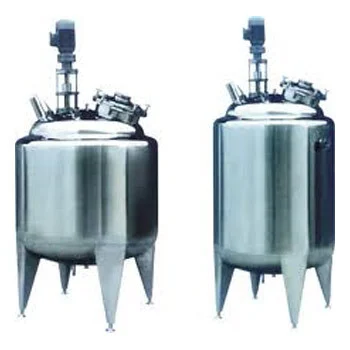Choosing the right stainless steel tank for your business is a crucial decision that impacts both the efficiency and longevity of your operations. Whether you’re in the food and beverage industry, pharmaceuticals, or manufacturing, stainless steel tanks are highly durable, corrosion-resistant, and versatile. However, selecting the ideal tank involves more than just picking a material; it requires understanding your specific needs, such as capacity, design, and environmental factors.
In this blog post, we’ll guide you through the key considerations when choosing the right stainless steel tank for your business. From understanding the types of stainless steel available to assessing customization options, these insights will help you make an informed decision.
1. Determine the Purpose of the Tank
The first step in choosing the right stainless steel tank is understanding its primary purpose. What type of liquid, gas, or solid will be stored or processed in the tank? Different industries have different needs, such as mixing, storing, or heating materials. For instance, food and beverage companies require tanks that meet sanitary standards, while chemical industries need tanks resistant to harsh chemicals. Identifying the tank’s purpose will narrow down the design and material requirements.
2. Select the Right Grade of Stainless Steel
Not all stainless steel is created equal. There are different grades of stainless steel, and each offers specific advantages depending on the intended use. The two most common grades used for tanks are 304 and 316 stainless steel.
Grade 304 is often used for general purposes and offers excellent resistance to corrosion, while grade 316 contains molybdenum, making it more resistant to chemical corrosion. Understanding the environment in which the tank will be used helps in selecting the right grade.
3. Consider Customization Needs
One of the most significant advantages of stainless steel tanks is their ability to be customized according to specific needs. Depending on your industry, you may require a tank with particular dimensions, fittings, or features like agitation systems or heating jackets. Custom stainless steel tanks are built to meet the unique demands of your processes, ensuring compatibility with your equipment and operational workflows.
To explore tailored solutions for your business, Custom Stainless Steel Tanks can provide specialized designs that ensure seamless integration with your operations.
4. Evaluate the Size and Capacity Requirements
The size and capacity of the tank are vital factors in determining its functionality. Over- or under-sizing your tank can lead to inefficiencies in your production or storage process. Consider your production volume, space availability, and the nature of the material being stored when determining the tank size. It’s also crucial to consider future growth selecting a tank with adequate capacity for expansion will save on costs in the long term.
5. Look for Durability and Corrosion Resistance
One of the key benefits of stainless steel is its durability, but even within this material, some tanks are more resistant to specific environmental factors than others. For example, tanks exposed to harsh chemicals or extreme temperatures require enhanced corrosion resistance.
Tanks made from 316-grade stainless steel offer superior resistance to corrosive environments compared to 304-grade. Assess the environment and potential exposure to corrosive materials to ensure your tank lasts as long as possible without maintenance or replacement.
6. Consider Temperature and Pressure Conditions
When choosing a stainless steel tank, it’s essential to factor in the temperature and pressure conditions under which the tank will operate. Some tanks need to withstand high-pressure processes or extreme temperature fluctuations.
Understanding the operational environment allows you to choose the correct thickness, pressure rating, and additional features like insulation or heating jackets. Custom tanks can also be engineered to handle unique environmental conditions, ensuring long-term reliability.
7. Ensure Compliance with Industry Standards
Different industries have specific standards and regulations regarding the use of stainless steel tanks. For instance, the food and beverage industry requires tanks that meet strict hygiene standards, such as those outlined by the FDA.
Pharmaceutical companies also follow stringent regulations for storage and mixing tanks to ensure product purity and safety. Always ensure that the tank you select complies with the necessary industry standards to avoid legal and operational issues.
8. Choose the Right Accessories and Features
Accessories and features play a crucial role in optimizing the performance of your stainless steel tank. Consider additional features like valves, sight gauges, agitation systems, or manways that can make your tank more efficient and easier to operate. Depending on your operational needs, you may also require tanks with heating or cooling capabilities. Custom stainless steel tanks can include these features, providing a solution perfectly tailored to your business requirements.
9. Budget Considerations
While choosing the right stainless steel tank is critical, budget constraints also play a role in the decision-making process. It’s essential to balance the need for high-quality materials and customization with budgetary limitations. While stainless steel tanks are a long-term investment, understanding your financial constraints helps you select a tank that provides the best value without compromising quality or functionality.
FAQs
What is the difference between 304 and 316 stainless steel tanks?
Grade 304 stainless steel is suitable for most general applications, offering excellent corrosion resistance and affordability. Grade 316 stainless steel contains molybdenum, making it more resistant to chemical corrosion and suitable for environments exposed to harsh chemicals or saline conditions.
Why should I consider custom stainless steel tanks for my business?
Custom stainless steel tanks are designed to meet the unique specifications of your business operations. They ensure that the tank is compatible with your equipment, optimizes workflow, and meets industry-specific standards. Custom tanks are also adaptable to various features such as agitation, heating, or insulation.
How do I determine the correct tank size for my operations?
The correct tank size depends on your production volume, available space, and material being stored or processed. It’s essential to consider both current needs and future growth to select a tank with adequate capacity that ensures efficiency and long-term savings.
What industries benefit most from stainless steel tanks?
Stainless steel tanks are widely used in industries such as food and beverage, pharmaceuticals, chemicals, and manufacturing. These tanks are known for their durability, corrosion resistance, and ability to maintain hygiene and safety standards, making them ideal for storing or processing a wide range of materials.
Conclusion
Choosing the right stainless steel tank requires careful consideration of various factors, including the purpose, material grade, customization needs, size, and environmental conditions. By assessing these key areas, you can ensure that your investment not only meets your current operational demands but is also scalable for future growth. Whether you need a standard tank or a customized solution, stainless steel tanks offer durability, versatility, and long-term reliability.

